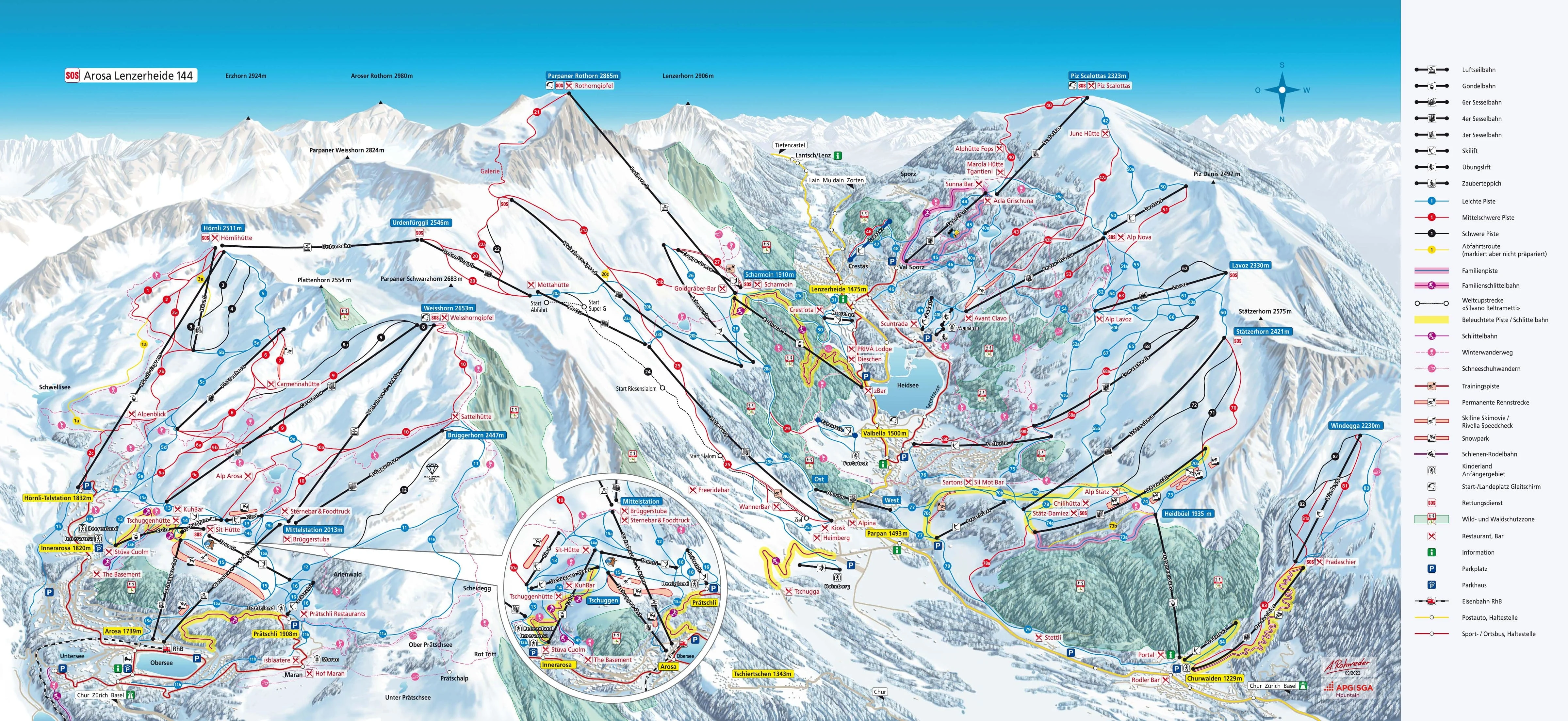

Arosa is a snow-sure Swiss ski destination in the canton of Graubünden, celebrated for its tranquil mountain village charm, well-groomed runs, and scenic alpine lakes. The ski area forms part of Arosa–Lenzerheide, offering 225 km (139 mi) of slopes across varied terrain, from beginner-friendly pistes to higher-altitude steeps around the Weisshorn. Families appreciate Arosa’s cosy atmosphere, beginners flock to gentle slopes near Tschuggen, while intermediates and advanced riders can explore the extended terrain linking to Lenzerheide. Off-slope, you’ll find classical Swiss hospitality, panoramic winter walks, sledging routes, and a low-key après-ski scene, making Arosa an ideal setting for a relaxed Alpine getaway.
Here's a practical guide we've put together just for you, filled with insider tips and essential info to help you plan the perfect Arosa ski holiday. You'll learn everything you need to know, from its location to its ski areas, snow history, and the best spots to grab a bite or relax after skiing.
Let's get started!
Arosa lies in eastern Switzerland, in the Schanfigg Valley of the Graubünden canton, at the head of a remote valley above the city of Chur.
Nearest airport
Transfer time
| Pros | Cons |
|---|---|
| Snow-sure altitude | Nightlife is relatively low-key |
| Picturesque lakeside setting | Village can feel shaded mid-winter due to valley location |
| Ideal for families, beginners, and intermediates | Limited advanced challenges |
| Classic Swiss charm | Steep roads into the resort require caution if self-driving in poor weather |
This short video provides a glimpse of everything Arosa has to offer.
Arosa caters well to beginners with sunny nursery slopes around Innerarosa and Tschuggen, served by gentle lifts. Ski schools (including English-speaking instructors) nurture confidence on wide, mellow runs away from the busiest areas. Once novices master first turns, easy blues link from mid-stations, letting them explore scenic vantage points without tackling steep pitches.
The majority of Arosa’s slopes suit intermediate skiers, featuring rolling reds off Hörnli or sweeping runs from Brüggerhorn. Linking to Lenzerheide doubles the fun, allowing mid-level skiers to roam widely across 225 km, sampling sunny runs in both valleys. Short queue times midweek and reliable grooming enhance the cruising experience, particularly on scenic routes that thread through pine forests near the village.
Although not famed for huge vertical or extreme steeps, Arosa hosts some black runs, particularly off the Weisshorn, and pockets of off-piste near Brüggerhorn. The new 6-seater chair there has improved advanced access to short but challenging lines. However, advanced or expert riders typically relish the extended terrain in Lenzerheide, accessible via the Urdenbahn cable car, offering more extensive red/black combos and additional freeride potential.
Snowboarders enjoy wide slopes and minimal queues, ideal for freeriding or casual cruising. Several terrain park areas exist in the combined Arosa–Lenzerheide domain, such as Snowpark Tschuggen in Arosa, offering lines for both novices and experts. The updated lifts (6-seater Brüggerhorn, among others) reduce time on drags, though a few T-bars remain. If carving is your thing, Arosa’s corduroy grooming suits morning runs perfectly before crossing to Lenzerheide for further exploration.
While some designated freeride segments exist, Arosa’s main off-piste draws revolve around smaller powder fields between marked slopes. Good snow transforms the Brüggerhorn sector into a freerider’s playground, though caution is crucial. For bigger freeride lines, the Lenzerheide area complements Arosa’s limited advanced scope.
The ski season in Arosa for 2024/25 started on December 21st and it's expected to run until March 30th, though dates may vary depending on snow conditions. If you're planning a ski holiday to Arosa this winter, be sure to explore our Arosa deals for the best ski offers available.
Arosa offers optimal snow conditions from December through April, each month presenting unique opportunities for skiers. December and January consistently bring about 27 cm (10.6 in) of snow respectively, dispersed across roughly 3.2 days each week, ensuring regular fresh snow. February's snowfall decreases to 24 cm (9.4 in) but it occurs more frequently, averaging 3.4 days per week. The pinnacle of snowfall arrives in the first week of February, traditionally the snowiest week in Arosa, with an impressive 37 cm (14.5 in) of snow over 4.2 days, making it a paradise for those who cherish Bluebird Powder Days, when sunshine and light winds follow fresh snowfall. The season stretches into April with enjoyable conditions, accumulating 21 cm (8.26 in) of snow over 3.3 days.
| Month | Snow amount (week) | Snow days (week) |
|---|---|---|
| December | 27 cm (10.6 in) | 3.3 days |
| January | 27 cm (10.6 in) | 3.2 days |
| February | 24 cm (9.4 in) | 3.4 days |
| March | 24 cm (9.4 in) | 3.7 days |
| April | 21 cm (8.2 in) | 3.3 days |
(Ref: snow-forecast.com)
Arosa’s dining landscape merges rustic Swiss traditions, like fondue, raclette, and rösti, with modern alpine gastronomy. Expect mountain huts perched at scenic points, plus a mix of hotel-based restaurants and village eateries. Highlights include:
While typically Swiss in cost, the quality is generally high, from quick daytime stops to multi-course mountain dinners with panoramic vistas.
Après-ski in Arosa is relatively low-key compared to Swiss giants like Verbier or St. Moritz but still offers a pleasant social scene. Highlights include:
Most nights revolve around relaxed dining, quiet drinks, or restful chalet evenings, aligning with Arosa’s family-friendly and romantic vibe rather than an intense party atmosphere.

Download Arosa-Lenzerheide piste map here